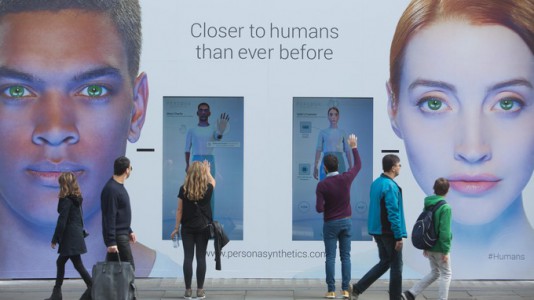Just published on the IAB website, OMD’s Strategy Director Marcos Angelides discusses the future of robots and tries to solve the question – who’s going to pay for all this technology?
The materials have been tested and the software is ready, so what’s taking the robotic revolution so long to get here?
The problem, as always, is cost.
Seeing as current smartphones and watches range from £500-£10,000+ it’s fair to imagine that a life-sized robot who walks, talks, cooks, cleans, protects and provides will have a price point closer to a supercar than a sandwich maker.
So how will people ever have a chance to own one?
AFR (Ad Funded Robotics)
The ad industry has bankrolled every media innovation since the 1950’s; so if it ‘aint broke, why fix it! Through this simple and familiar model, people will have the robotic companion they always dreamed of without having to worry about the cost.
But if brands are going to pick up the pay check, what benefits can they expect?
In-home Contextual Ads
In this utopian future, Robotic Companions will be waiting for you us when we arrive home at night, always ready to respond to our questions and provide us with what we need.
So if you were to take your shoes off and rubs your sore ankles, the Robotic Companion may suggest a new insole that better supports your feet. Or when you mention how miserable the weather is the Robotic Companion could share the evening flight times to Portugal.
This will fundamentally change the way contextual ads are served. Messages will no longer be delivered against a short list of keywords in the hope that they are relatable; they’ll be pre-loaded into a Robotic Companion’s processor, ready to be retrieved when the time is right.
The cost of these ads will depend on the amount of processor time a brand purchases. Those who buy a better package will be able to wait longer, increasing the chance of finding the perfect contextual moment.
Personalised Discounts
As our Robotic Companions will be doing all of the cooking and cleaning it makes sense that they’ll also purchase our household products. We will tell them to make these decisions primarily based on value, which will lead to a completely new buying model.
Brands will be able to purchase psychometric data and historical purchase patterns of potential customers in order to determine their lifetime value. This will allow them to offer a personalised discount to convert that person, through their Robotic Companion, to trial.
This will lead to the end of fixed-priced products, as the cost of a product will depend entirely on the individual.
Campaign Measurement
“Half the money I spend on advertising is wasted; the trouble is I don’t know which half”. In the future, Robotic Companions will laugh mechanically at that comment.
Measurement will be the lifeblood of the AFR model and provide brands with endless access to their customers.
Claimed exposure will become redundant as Robotic Companions will be able to confirm when their owner has been exposed to an ad. As a result, the industry will finally have their ‘one unifying metric’ to link all media channels together and evaluate the attribution of each.
But the real winner will be qualitative data. Brands will finally have a way to ask customers their opinions within their natural environments. For a premium cost, brands will be able to blend their questions into the Robotic Companion’s natural conversation so that their owners aren’t even aware it’s taking place.
Anti-Robo or Pro-Robo?
The idea of AFR may be a concern for some, questions about privacy and the increasing intrusion of big business is an issue today let alone for the future.
But AFR may also have a hugely positive effect on society. The use of advertising will make Robotic Companions affordable for all – ensuring that the elderly, vulnerable and impoverished are not left behind during the technological revolution.
From the perspective of consumerism, brands will also have a greater understanding of what people genuinely care about. This will allow them to improve the quality of their products and the nature of their advertising to add true value to people’s lives.
But with great information comes great responsibility. If brands choose to use AFR unwisely they’ll soon be battling against a raft of Robotic Ad Blockers and the potential end to free robotics.
Just like now, the future is in flux as it tries to determine the role of advertising.
What happens next, even a robot can’t predict.
(Shoppers were given a taste of the future this year when OMD UK and Channel 4 created a retail space for Robotic Companions)





